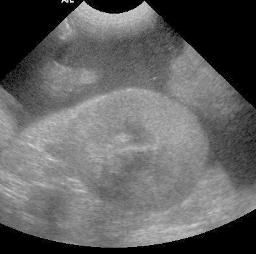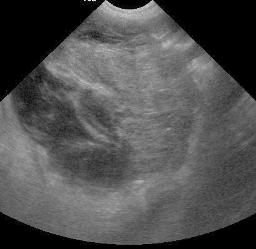Hemangiosarcoma
Abstract
11 year old MC Weimeraner with collapse and ataxia
Copyright Veterinaryradiology.net
Publication Date: 2007-01-22
History
An 11 year old Weimeraner with 2 weeks of inappetance and 1 week of intermittent retching.
On bloodwork there was a regenerative anemia (20%), leukocytosis (17,000), neutrophilia, thrombocytopenia (108,000), and mild bilirubinemia. Today he became ataxic on both pelvic limbs.
2 images
Findings
There is poor peritoneal detail and distension of the abdomen. There is a mass effect in the mid-abdomen on the lateral projection, and a more well-defined mass caudal to the stomach on the v/d projection. The small intestine is displaced caudally on the lateral projection.
Diagnosis
Splenic mass - hemangiosarcoma
Additional Images


The ultrasound images show a large amount of echogenic effusion, consistent with hemorrhage. The splenic mass is of mixed echogenicity, with solid and cystic components.
Discussion
Most large mid-abdominal masses are splenic in origin. Pedunculated liver masses occasionally appear caudal to the stomach however. The two most common causes of splenic masses in dogs are hemangiosarcoma and hematoma. Fine needle aspirates are usually not diagnostic, and splenectomy is generally required for treatment and diagnosis.